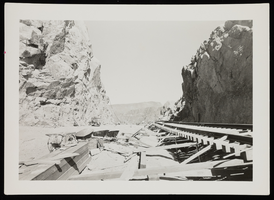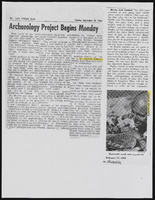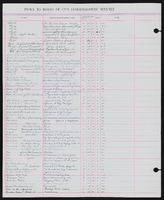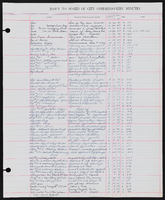Search the Special Collections and Archives Portal
Search Results

Photograph of railroad, Hoover Dam, circa 1932
Date
Archival Collection
Description
Image

Transcript of interview with Harvey N. Dondero by Elizabeth N. Patrick, August 9, 1984
Date
Archival Collection
Description
Text

Transcript of interview with Rosina Goodwin by Bruce Eubank, March 15, 1978
Date
Archival Collection
Description
On March 15, 1978, Bruce Eubank interviewed Rosina Goodwin (born 1918 in Sweet Springs, Missouri) about her life in Las Vegas, Nevada. Goodwin first talks about her family background before discussing the Las Vegas Strip, the Stewart Ranch, and Twin Lakes. She also talks about schools, Boulder Dam, the atomic testing, and her work as a telephone operator. The latter part of the interview includes discussion on changes in Las Vegas, the Helldorado Parade, and changes in weather.
Text
A. J. Shaver Papers
Identifier
Abstract
A. J. Shaver Papers (1925-1964) include hearings, reports, Senate bills, bulletins, and surveys regarding the Boulder Canyon Project/Colorado River Development. There are also papers about Marienne Shaver's involvement in the Las Vegas High School Parent Teacher's Association (PTA) and the Girl Scouts of America (GSA), including minutes, correspondence, notes, and brochures.
Archival Collection
Hildred Meidell oral history interview
Identifier
Abstract
Oral history interview with Hildred Meidell conducted by Greg Abbott on February 27, 1979 for the Ralph Roske Oral History Project on Early Las Vegas. In this interview, Meidell covers a range of topics about living in Las Vegas, Nevada, from her and her husband’s time as tourists in the city and their subsequent retirement to Las Vegas from Los Angeles, California. Meidell describes the Las Vegas Strip, the interstate and highway conditions between Los Angeles and Las Vegas, as well as their numerous visits to Hoover Dam (Boulder Dam). Moreover, she speaks about the changing layout of the city, the increase in shopping centers and department stores, and the clothing stores inside of hotels. Lastly, Meidell talks about the prominence of churches in local communities, the atomic testing program and the structural damages these tests caused in her neighborhood, and the influence of the railroad and passenger train on the town.
Archival Collection
Blood, Leonard T., 1894-1962
District Deputy Labor Commissioner Leonard Blood worked for the Las Vegas Labor Commission, hiring employees for the construction of the Boulder (later renamed Hoover) Dam from 1931 to 1938 in Nevada. Blood, born on November 7, 1894, came to Nevada from Lincoln, Nebraska with his parents, William Blood, a train conductor and his mother, Carrie Blood, a nurse. During Blood's time as the District Deputy Labor Commissioner, it was his responsibility to hire employees for the construction of the Boulder Dam.
Person

Transcript of interview with Stella Iaconis by Gary Gione, February 26, 1976
Date
Archival Collection
Description
On February 26, 1976, Gary Gione interviewed Stella Iaconis (born September 16th, 1910 in Italy) about her life in Southern Nevada. The two discuss Iaconis’ reasons for moving to Las Vegas as well as her childhood memories of Hooverville. Iaconis also talks about seeing the above-ground atomic tests in Southern Nevada from Los Angeles, and the drastic population growth that occurred after the construction of Hoover Dam.
Text



